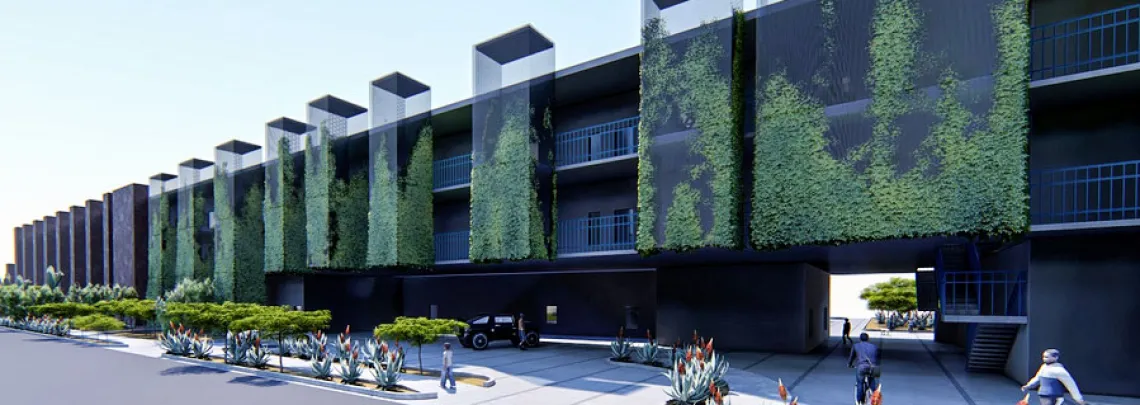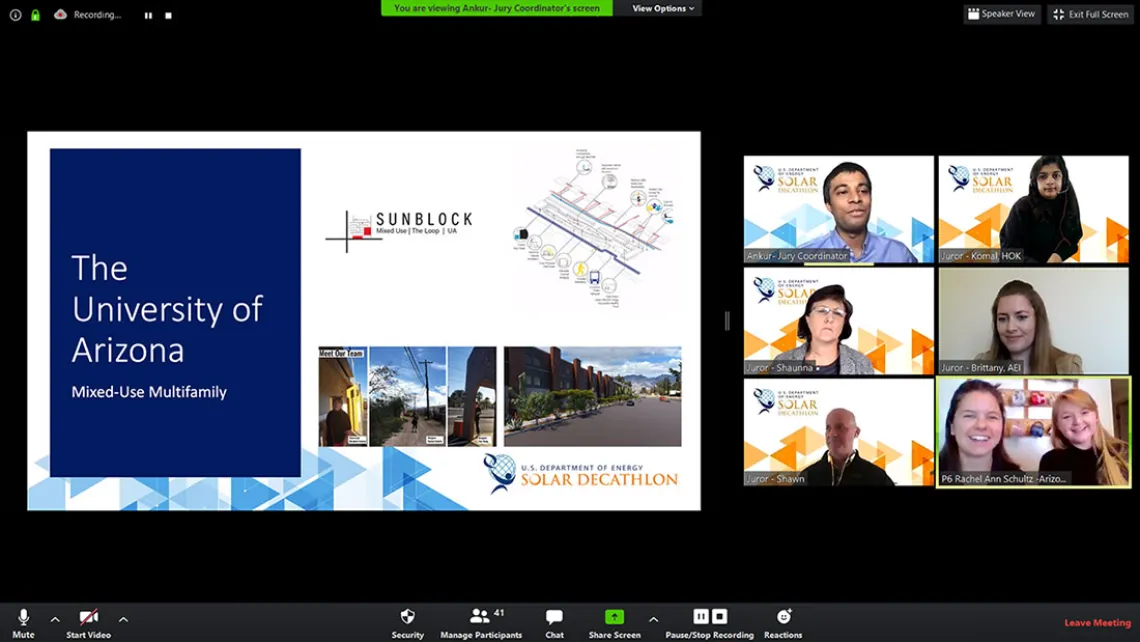CAPLA Places Four Finalist Teams in Solar Decathlon Design Challenge, Including a Winner and Honorable Mention

The Loop SunBlock Mixed Use Multifamily. Image courtesy Elizabeth Franzen, Rachel Schultz and Hao Wang.
In a world where quality doesn’t always trump quantity, the University of Arizona’s win in the U.S. Department of Energy’s 2020 Solar Decathlon Design Challenge holds special significance. The winning team of fourth-year undergraduate architecture students was comprised of only three members—Elizabeth Franzen, Rachel Schultz and Hao Wang—compared to the teams they competed against, which often had multiple faculty advisors and up to two dozen students per team. The UArizona team took first place in the Mixed-Use Multifamily Division for their SunBlock concept called The Loop.
“That says a lot about the dedication, ingenuity and collaboration of the students in the studio and beyond,” says the teams’ faculty advisor, Assistant Professor of Architecture Jonathan Bean, who is also a PHIUS-certified passive house consultant.

During the presentation by the winning SunBlock team of Elizabeth Franzen, Rachel Schultz and Hao Wang. Image courtesy U.S. Department of Energy.
But quantity counts, too, at least when considering the number of CAPLA teams named finalists in this year’s Challenge: four out of a total of 45 teams representing 31 universities across the world. Of those, the CAPLA team of Carina Eichorst ’21 B.Arch, Alec Kelly-Jones ’22 M.Arch and Wen Xie ’21 B.Arch also placed, receiving an honorable mention in the Elementary School Division.
CAPLA also fielded finalist teams of fourth-year students who made strong presentations in the Suburban Single Family (Josh Muckenthaler, Sierra Yang, Chumei Rui and Nikolas Altamura, all B.Arch) and Urban Single Family (Courtney Klewer B.Arch, Juli Bailey B.Arch and Sasha Evans BS Sustainable Built Environments) Divisions. Students who gained specialized expertise on each cross-functional team helped other teams incorporate complex ideas quickly. The teams started in January and worked up to a major deadline at the end of March, taking the shift to remote learning in stride.
Many competing teams in the Solar Decathlon Design Challenge work over two semesters or more to design and build highly efficient and innovative buildings powered by renewable energy. According to the DOE, the winners are “those teams that best blend architectural and engineering excellence with innovation, market potential, building efficiency and smart energy production.”
Teams that qualify as finalists attend the Solar Decathlon Design Challenge Weekend—this year, held virtually due to the COVID-19 pandemic—where they present their designs to a panel of industry expert jurors, compare their projects to those of other teams, learn from presentations by thought leaders and engage with a variety of organizations about energy-related careers. This year the networking was done virtually, with CAPLA’s teams joining a celebratory Zoom call with the grand prize winners from Miami University in Ohio.
“The Solar Decathlon Design Challenge is one of the most important activities in which I’ve participated,” says Schultz of her experience on the winning Mixed-Use Multifamily Division team. “The judges are leaders in the sustainable built environment, people who have all done amazing things for the world. For our hard work to be recognized by them as outstanding among so many innovative ideas is not only affirming, but also a reminder that we are the ones who will be filling their shoes.”
Kelly-Jones of the Elementary School Division team that won an honorable mention agrees: “The Design Challenge has provided me with some of the most fulfilling experiences of my academic career. The team-based experience has taught me the means and methods of designing an energy-efficient, net-zero building economically. The development of these skillsets helps me to tackle my true passion—combating climate change through the built environment. I am grateful for this foundation.”
All four of CAPLA’s teams built their projects around what they call the SunBlock solution—a distributed district heating and cooling system to generate and store carbon-neutral thermal energy and share it with the neighborhood, or micro-community. The SunBlock concept reduces stress on the electrical grid and offers residents an economical alternative for space conditioning by using water as a vehicle for storing and sharing abundant solar energy through a community energy system.

Goals of The Loop SunBlock Mixed Use Multifamily. Image courtesy Elizabeth Franzen, Rachel Schultz and Hao Wang.
The students’ projects are an important first step towards a more sustainable future for Tucson and other low-density cities. TEP, Tucson’s electric utility, helped the students learn about the integration of renewable energy with the grid and provided $5,000 in funding to support the student teams. Students in future studios will continue to move the project towards reality.
Learn more about SunBlock and the Solar Decathlon Design Challenge.



